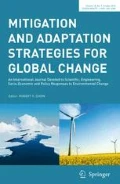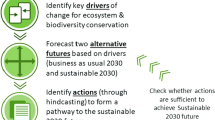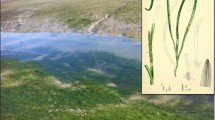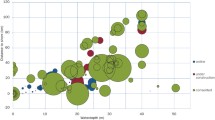Abstract
Management of marine mega-fauna in a changing climate is constrained by a series of uncertainties, often related to climate change projections, ecological responses, and the effectiveness of strategies in alleviating climate change impacts. Uncertainties can be reduced over time through adaptive management. Adaptive management is a framework for resource conservation that promotes iterative learning-based decision making. To successfully implement the adaptive management cycle, different steps (planning, designing, learning and adjusting) need to be systematically implemented to inform earlier steps in an iterative way. Despite the critical role that adaptive management is likely to play in addressing the impacts of climate change on marine mega-fauna few managers have successfully implemented an adaptive management approach. We discuss the approaches necessary to implement each step of an adaptive management cycle to manage marine mega-fauna in a changing climate, highlighting the steps that require further attention to fully implement the process. Examples of sharks and rays (Selachimorpha and Batoidea) on the Great Barrier Reef and little penguins, Eudyptula minor, in south-eastern Australia are used as case studies. We found that successful implementation of the full adaptive management cycle to marine mega-fauna needs managers and researchers to: (1) obtain a better understanding of the capacity of species to adapt to climate change to inform the planning step; (2) identify strategies to directly address impacts in the marine environment to inform the designing step; and (3) develop systematic evaluation and monitoring programs to inform the learning step. Further, legislation needs to flexible to allow for management to respond.

Similar content being viewed by others
References
Allen CR, Gunderson LH (2011) Pathology and failure in the design and implementation of adaptive management. J Environ Manage 92:1379–1384
Allen CR, Fontaine JJ, Pope KL, Garmestani AS (2011) Adaptive management for a turbulent future. J Environ Manage 92:1339–1345
Angélil O, Stone DA, Tadross M et al (2014) Attribution of extreme weather to anthropogenic greenhouse gas emissions: Sensitivity to spatial and temporal scales. Geophys Res Lett 41:2150–2155
Bowen BW, Karl SA (2007) Population genetics and phylogeography of sea turtles. Mol Ecol 16:4886–4907
Bulman C, Chiaradia A, Kirkwood R et al (2012) Modelling the marine ecosystem within the foraging zone of Phillip Island Little Penguins. Report, Phillip Island Nature Parks Fellowship
Burek KA, Gulland FMD, O’Hara T (2008) Effects of climate change on artic marine mammal health. Ecol Appl 18:126–134
Charmantier A, Gienapp P (2014) Climate change and timing of avian breeding and migration: evolutionary versus plastic changes. Evol Appl 7:15–28
Carrier JC, Musick JA, Heithaus MR (eds) (2004) Biology of sharks and their relatives. CRC Press, Boca Raton
Chambers LE, Renwick L, Dann P (2009) Climate, fire and Little Penguins. In: Steffen W (ed) Australia’s Biodiversity and Climate Change. CSIRO Publishing, Melbourne, Australia
Chambers LE, Devney C, Congdon B et al (2011) Observed and predicted effects of climate on Australian seabirds. Emu 111:235–251
Cheung WWL, Sarmiento JL, Dunne J et al (2013) Shrinking of fishes exacerbates impacts of global ocean changes on marine ecosystems. Nat Clim Chang 3:254–258
Chin A, Kyne PM, Walker TI et al (2010) An integrated risk assessment for climate change: analysing the vulnerability of sharks and rays on Australia's Great Barrier Reef. Glob Change Biol 16:1936–1953
Chin A, White J, Dulvy NK (2012) Aquatic conservation: Environment in Queensland at risk. Nature 90:176
Conroy MJ, Runge MC, Nichols JD et al (2011) Conservation in the face of climate change: The roles of alternative models, monitoring, and adaptation in confronting and reducing uncertainty. Biol Conserv 144:1204–1213
Constable AJ, Melbourne-Thomas J, Corney SP et al (2014) Climate change and Southern Ocean ecosystems I: How changes in physical habitats directly affect marine biota. Glob Change Biol. doi:10.1111/gcb.12623
Cullen JM, Chambers LE, Coutin P et al (2009) Predicting onset and success of breeding in little penguins Eudyptula minor from ocean temperatures. Mar Ecol-Prog Ser 378:269–278
Dann P (1992) Distribution, population trends and factors influencing the population size of little penguins Eudyptula minor on Phillip Island. Victoria Emu 91(5):263–272
Dann P, Chambers LE (2013) Ecological affects of climate change on little penguins Eudyptula minor and the potential economic impact on tourism. Climate Res 58:67–79
Dawson TP, Jackson ST, House JI et al (2011) Beyond Predictions: Biodiversity Conservation in a Changing Climate. Science 332:53–58
Day J (2008) The need and practice of monitoring, evaluating and adapting marine planning and management-lessons from the Great Barrier Reef. Mar Policy 32:823–831
Dobbs K, Day J, Skeat H et al (2011) Developing a long-term outlook for the Great Barrier Reef, Australia: A framework for adaptive management reporting underpinning an ecosystem-based management approach. Mar Policy 35:233–240
Douvere F, Ehler CN (2011) The importance of monitoring and evaluation in adaptive maritime spatial planning. J of Coast Conservat 15:305–311
Drinkwater KF (2006) The regime shift of the 1920s and 1930s in the North Atlantic. Prog Oceanogr 68:134–151
Edwards H (2013) Potential impacts of climate change on warmwater megafauna: the Florida manatee example (Trichechus manatus latirostris). Climatic Change 121:727–738
Ferraro PJ (2009) Counterfactual thinking and impact evaluation in environmental policy. New Dir Eval 122:75–84
Fordham DA, Akçakaya HR, Araújo MB et al (2013) Tools for integrating range change, extinction risk and climate change information into conservation management. Ecography 36:956–964
Fontaine JJ (2011) Improving our legacy: Incorporation of adaptive management into state wildlife action plans. J Environ Manage 92:1403–1408
Fuentes MMPB, Cinner JE (2010) Using expert opinion to prioritize impacts of climate change on sea turtles’ nesting grounds. J Environ Manage 91:2511–2518
Fuentes MMPB, Limpus CJ, Hamann M et al (2010) Potential impacts of projected sea-level rise on sea turtle rookeries. Aquat Conserv 20:132–139
Fuentes MMPB, Limpus CJ, Hamann M (2011) Vulnerability of sea turtle nesting grounds to climate change. Glob Change Biol 17:140–153
Fuentes MMPB, Fish MR, Maynard JA (2012) Management strategies to mitigate the impacts of climate change on sea turtle’s terrestrial reproductive phase. Mitig Adapt Strateg Glob Change 17:51–63
Fuentes MMPB, Cleguer C, Liebsch N et al (2013) Adapting dugong catching techniques to different cultural and environmental settings. Mar Mammal Sci 29:159–166
Fulton EA (2011) Interesting times: winners, losers, and system shifts under climate change around Australia. ICES Mar Sci 68:1329–1342
Ganendran L, Sidhu L, Catchpole EA et al (2011) The effect of directional wind components on survival of Little Penguins Eudyptula minor. ANZIAM 52:1012–1030
Gibbs JP, Snell HL, Causton CE (1999) Effective Monitoring for Adaptive Wildlife Management: Lessons from the Galápagos Islands. J Wildl Manage 63:1055–1065
Great Barrier Reef Marine Park Authority (2009) Great Barrier Reef Outlook Report 2009. Great Barrier Reef Marine Park Authority. Townsville, Australia
Gremillet D, Boulinier T (2009) Spatial ecology and conservation of seabirds facing global climate change: a review. Mar Ecol-Prog Ser 391:121–137
Groves C, Game E, Anderson M et al (2012) Incorporating climate change into systematic conservation planning. Biodivers Conserv 21:1651–1671
Gunn J, Meere F, Stevens J (eds) (2008) Independent Review proposed Management Arrangements for Queensland's East Coast Inshore Fin Fish Fishery. Department of the Environment, Heritage and the Arts, Canberra
Hailer F, Kutschera VE, Hallström BM et al (2012) Nuclear genomic sequences reveal that polar bears are an old and distinct bear lineage. Science 336:344–347
Hamann M, Fuentes MMPB, Ban N et al (2013) Climate change and marine turtles. In: Wyneken J, Lohmann KL, Musick JA (eds) The biology of sea turtles. Taylor & Francis Group, Boca Ranton, pp 353–378
Hansen L, Hoffman J, Drews C et al (2009) Designing climate-smart conservation: guidance and case studies. Conserv Biol 24:63–69
Hawkes LA, Broderick AC, Godfrey MH et al (2009) Climate change and marine turtles. Endang Species Res J 7:137–154
Hazen EL, Jorgensen S, Rykaczewski RR et al (2013) Predicted habitat shifts of Pacific top predators in a changing climate. Nature Clim Change 3:234–238
Heller NE, Zavaleta ES (2009) Biodiversity management in the face of climate change: A review of 22 years of recommendations. Biol Conserv 142:14–32
Heupel MR, Williams AJ, Welch DJ et al (2009) Effects of fishing on tropical reef associated shark populations on the Great Barrier Reef. Fish Res 95:350–361
Hobday AJ (2011) Sliding baselines and shuffling species: implications of climate change for marine conservation. Mar Ecol 32:392–403
Hockings M, Stolton SND (eds) (2000) Evaluation effectiveness: a framework for assessing the management of protected areas. IUCN World Commission on Protected Areas Best Practice Protected Area Guidelines, Gland, Switzerland/Cambridge
Holbrook N, Johnson J (2014) Climate change impacts and adaptation of commercial marine fisheries in Australia: a review of the science. Climatic Change 1–13
Holling CS (1978) Adaptive Environmental Assessment and Management. Wiley, London, UK
Huntington HP (2000) Using traditional ecological knowledge in science: methods and applications. Ecol Appl 10:1270–1274
Huntington HP (2009) A preliminary assessment of threats to arctic marine mammals and their conservation in the coming decades. Mar Policy 33:77–82
Intergovernmental Panel on Climate Change (2013) The Physical Science Basis. Contribution of Working Group I to the Fifth Assessment Report of the Intergovernmental Panel on Climate Change. Cambridge, United Kingdom and New York, USA, p 1535
Intergovernmental Panel on Climate Change (2014) Climate Change 2014: Impacts, Adaptation, and Vulnerability: Working Group II Contribution to the IPCC 5th Assessment Report. United Kingdom and New York, USA, Cambridge, p 1535
Isaac JL, Vanderwal J, Johnson CN et al (2009) Resistance and resilience: quantifying relative extinction risk in a diverse assemblage of Australian tropical rainforest vertebrates. Divers Distrib 15:280–288
Jones G (2009) the adaptive management system for the Tasmanian Wilderness World Heritage Area – linking management planning with effectiveness evaluation. In: Allan C, Stankey G (eds) Adaptive environmental management a practitioner’s guide. Jointly published by Springer with CSIRO Publishing, Collingwood, Australia, p 360
Johnson JE, Marshall PA (eds) (2007) Climate change and the Great Barrier Reef. Great Barrier Reef Marine Park Authority and Australian Greenhouse Office, Townsville, Australia, p817
Jourdan J, Fuentes MMPB (2013) Effectiveness of strategies at reducing sand temperature to mitigate potential impacts from changes in environmental temperature on sea turtle reproductive output. Mitig Adapt Strateg Glob Change. DOI 10 1007/s11027-013-9482-y
Kearney MR, Wintle BA, Porter WP (2010) Correlative and mechanistic models of species distribution provide congruent forecasts under climate change. Conserv Lett 3:203–213
Keith DA, Martin TG, McDonald-Madden E et al (2011) Uncertainty and adaptive management for biodiversity conservation. Biol Conserv 144:1175–1178
Lawler JJ, Tear TH, Pyke C et al (2010) Resource management in a changing and uncertain climate. Front Ecol Environ 8:35–43
Lescroël A, Ballard G, Grémillet D et al (2014) Antarctic Climate Change: Extreme Events Disrupt Plastic Phenotypic Response in Adélie Penguins. PLoS ONE 9:e85291
Lyons JE, Runge MC, Laskowski HP et al (2008) Monitoring in the context of structured decision-making and adaptive management. J Wildl Manage 72:1683–1692
Madin EMP, Ban NC, Doubleday ZA et al (2012) Socio-economic and management implications of range-shifting species in marine systems. Global Environ Change 22:137–146
Marcovaldi M, Patiri V, Thome J (2005) Projeto tamar-ibama: Twenty-five years protecting Brazilian sea turtles through a community-based conservation programme. Mast 3:39–62
Marsh H, Dennis A, Hines H et al (2007) Optimizing allocation of management resources for wildlife. Conserv Biol 21:387–399
Marsh H, O'Shea TJ, Reynolds JE (2011) Ecology and conservation of the sirena: dugongs and manatees Cambridge University Press. Cambridge University Press, New York
Mawdsley JR, O’Malley R, Ojima DS (2009) A Review of climate-change adaptation strategies for wildlife management and biodiversity conservation. Conserv Biol 23:1080–1089
McDonald-Madden E, Probert WJM, Hauser CE et al (2010) Active adaptive conservation of threatened species in the face of uncertainty. Ecol Appl 20:1476–1489
McFadden JE, Hiller TL, Tyre AJ (2011) Evaluating the efficacy of adaptive management approaches: Is there a formula for success? J Environ Manage 92:1354–1359
McMahon CR, Hays GC (2006) Thermal niche, large-scale movements and implications of climate change for a critically endangered marine vertebrate. Glob Change Biol 12:1330–1338
McNie EC (2007) Reconciling the supply of and demand for science, with a focus on carbon cycle research. Environ Sci Policy 10:17–38
Meltz R (ed) (2008) Use of the polar bear listing to force reduction of greenhouse gas emissions: The legal arguments. Congressional Research Service, p 6
Moore SE, Huntington HP (2008) Artic marine mammals and climate change: impacts and resilience. Ecol Appl 18:S157–S165
Nichols JD, Williams BK (2006) Monitoring for conservation. Trends Ecol Evol 21:668–673
Nye JA, Link JS, Hare JA et al (2009) Changing spatial distribution of fish stocks in relation to climate and population size on the Northeast United States continental shelf. Mar Ecol-Prog Ser 393:111–129
Pahl-Wostl C (2007) Transitions towards adaptive management of water facing climate and global change. Water Resour Manag 21:49–62
Peron C, Authier M, Barbraud C et al (2010) Interdecadal changes in at-sea distribution and abundance of subantarctic seabirds along a latitudinal gradient in the Southern Indian Ocean. Glob Change Biol 16:1895–1909
Peterson G, De Leo GA, Hellmann JJ et al (1997) Uncertainty, Climate Change, and Adaptive Management. Ecol Soc 1:4
Pike DA (2014) Forecasting the viability of sea turtle eggs in a warming world. Glob Change Biol 20:7–15
Poloczanska ES, Limpus CJ, Hays GC (2009) Vulnerability of marine turtles to climate change. Adv Mar Biol 151–211
Povilitis A, Suckling K (2010) Addressing climate change threats to endangered species in US Recovery Plans. Conserv Biol 24:372–376
Purvis A, Gittleman JL, Cowlishaw G et al (2000) Predicting extinction risk in declining species. P Roy Soc Lond B Bio B 24:1947–1952
Redford KH, Taber A (2000) Writing the wrongs: developing a safe-fail culture in conservation. Conserv Biol 14:1567–1568
Robinson LM, Hobday AJ, Possingham HP et al (2014) Trailing edges projected to move faster than leading edges for large pelagic fish habitats under climate change. Topical Studies in Oceanography, Deep Sea Res Part II. doi:10.1016/j.dsr2.2014.04.007
Saba VS, Stock CA, Spotila JR et al (2012) Projected response of an endangered marine turtle population to climate change. Nature Clim Change 2:814–820
Schreiber ESG, Bearlin AR, Nicol SJ et al (2004) Adaptive management: a synthesis of current understanding and effective application. Ecol Manag Restoration 5:177–182
Schumann N, Gales NJ, Harcourt RG et al (2013) Impacts of climate change on Australian marine mammals. Aust J Zool 61:146–159
Sequeira AMM, Mellin C, Fordham DA et al (2014) Predicting current and future global distributions of whale sharks. Glob Change Biol 20:778–789
Sgrò CM, Lowe AJ, Hoffmann AA (2011) Building evolutionary resilience for conserving biodiversity under climate change. Evol Applications 4:326–337
Sidhu LA, Dann P, Chambers LE et al (2012) The effects of seasonal ocean temperatures in south-eastern Australia on the survival of first-year little penguins Eudyptula minor. Mar Ecol-Prog Ser 454:263–272
Simmonds MP, Isaac SJ (2007) The impacts of climate change on marine mammals: early signs of significant problems. Oryx 41:19–26
Stringer LC, Dougill AJ, Fraser E et al (2006) Unpacking Participation in the Adaptive Management of Social–ecological Systems: a Critical Review. Ecol and Soc 11:39
Sun C, Feng M, Matear RJ et al (2012) Marine downscaling of a future climate scenario for Australian boundary currents. J Climate 25:2947–2962
Tobin AJ, Simpendorfer CA, Mapleston A et al (2010) A quantitative ecological risk assessment of sharks and finfish of Great Barrier Reef World Heritage Area inshore waters: A tool for fisheries and marine park managers: Identifying species at risk and potential mitigation strategies. Marine and Tropical Sciences Research. Facility, Cairns
Tribbia J, Moser SC (2008) More than information: what coastal managers need to plan for climate change. Environ Sci Policy 11:315–328
Van Dao H, Maher L, Bigger SW et al (2006) Removal of petroleum tar from bird feathers utilizing magnetic particles. Environ Chem Lett 4:111–113
Van Houtan KS, Halley JM (2011) Long-term climate forcing in loggerhead sea turtle nesting. Plos One 6:e19043
Walters CJ, Hilborn R (1978) Ecological optimization and adaptive management. Annu Rev Ecol Syst 9:157–188
Weishampel JF, Bagley DA, Ehrhart LM (2004) Earlier nesting by loggerhead sea turtles following sea surface warming. Glob Change Biol 10:1425–1428
Weiss K, Hamann M, Kinney M et al (2012) Knowledge exchange and policy influence in a marine resource governance network. Global Environ Chang 22:178–188
Welch DJ, Johnson JE (2013) Assessing the vulnerability of Torres Strait fisheries and supporting habitats to climate change. Report to the Australian Fisheries Management Authority. C2O Fisheries, Australia, p 114
West J, Julius S, Kareiva P (2009) U S natural resources and climate change: concepts and approaches for management adaptation. Environ Manage 44:1001–1021
Westgate MJ, Likens GE, Lindenmayer DB (2013) Adaptive management of biological systems: A review. Biol Conserv 158:128–139
Williams BK (2011a) Passive and active adaptive management: Approaches and an example. J Environ Manage 92:1371–1378
Williams BK (2011b) Adaptive management of natural resources—framework and issues. J Environ Manage 92:1346–1353
Willis-Norton E, Hazen EL, Fossette S et al. (2014) Climate change impacts on leatherback turtle pelagic habitat in the Southeast Pacific. Deep Sea Res Part II: Topical Studies in Oceanography. DOI:org/10.1016/j.dsr2.2013.12.019i
Wilson C, Tisdell C (2001) Sea turtles as a non-consumptive tourism resource especially in Australia. Tour Manag 22:279–288
Wintle BA, Bekessy SA, Keith DA et al (2011) Ecological-economic optimization of biodiversity conservation under climate change. Nature Clim Change 1:355–359
Würsig B, Reeves RR, Ortega-Ortiz JG (2002) Global climate change and marine mammals. In: Evans PGH, Raga JA (eds) Biology and Conservation. Kluwer Academic/Plenum Publishers, New York USA
Wynn R, Josey S, Martin A et al (2007) Climate-driven range expansion of a critically endangered top predator in northeast Atlantic waters. Biol Lett 3:529–532
Žydelis R, Wallace BP, Gilman EL et al (2009) Conservation of marine megafauna through minimization of fisheries bycatch. Conserv Biol 23:608–616
Acknowledgments
The initial ideas for this paper were discussed during the Systematic management of marine mega-fauna in a changing climate symposium at the 25th International Congress for Conservation Biology in Auckland, New Zealand in 2011. The authors are grateful for comments on a draft manuscript by Sue Moore, Mark Read, and Phil Koloi and for later revisions by Nadine Marshall, Natalie Ban, Marianne Fish and Alistair Hobday, all of which improved the manuscript greatly. RLP acknowledge the support of the Australian Research Council (ARC). MMPBF is grateful for the support from the ARC, Save Our Seas Foundation, and the Ian Potter Foundation.
Author information
Authors and Affiliations
Corresponding author
Rights and permissions
About this article
Cite this article
Fuentes, M.M.P.B., Chambers, L., Chin, A. et al. Adaptive management of marine mega-fauna in a changing climate. Mitig Adapt Strateg Glob Change 21, 209–224 (2016). https://doi.org/10.1007/s11027-014-9590-3
Received:
Accepted:
Published:
Issue Date:
DOI: https://doi.org/10.1007/s11027-014-9590-3




